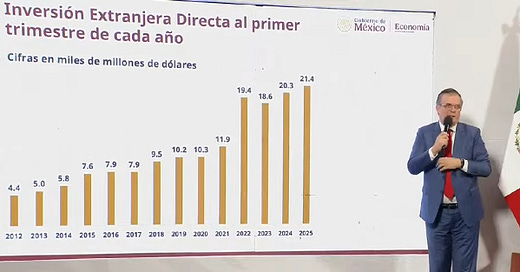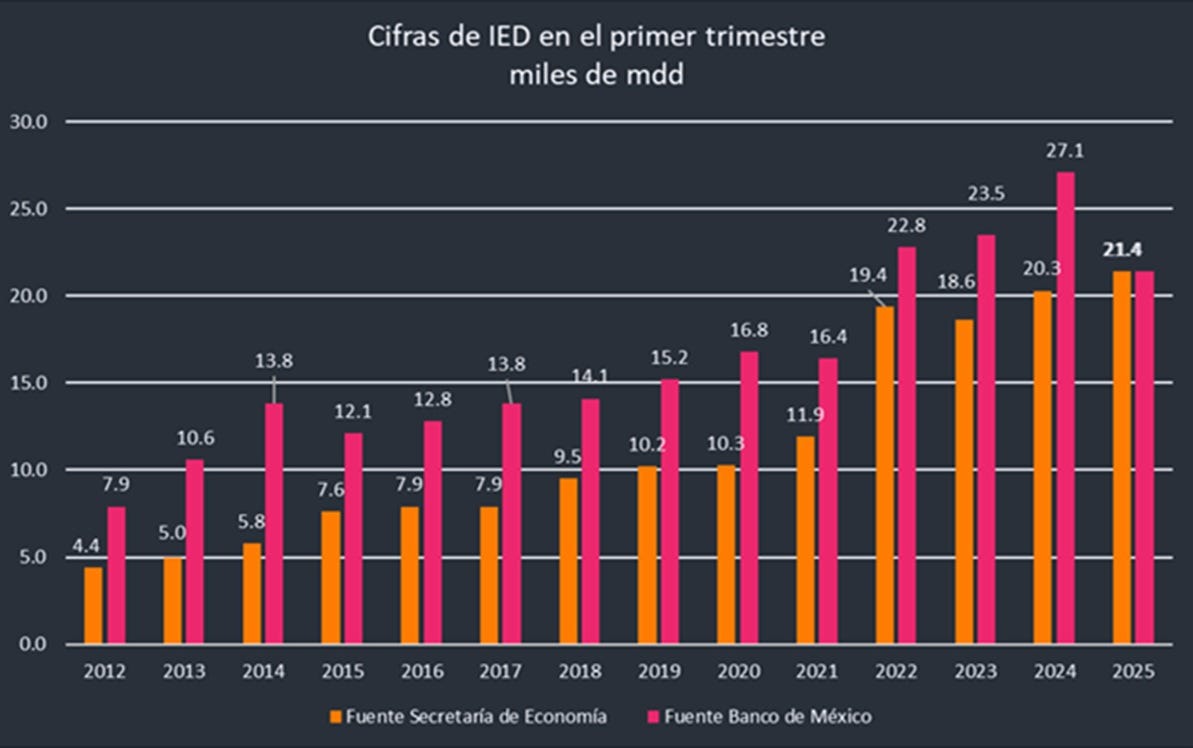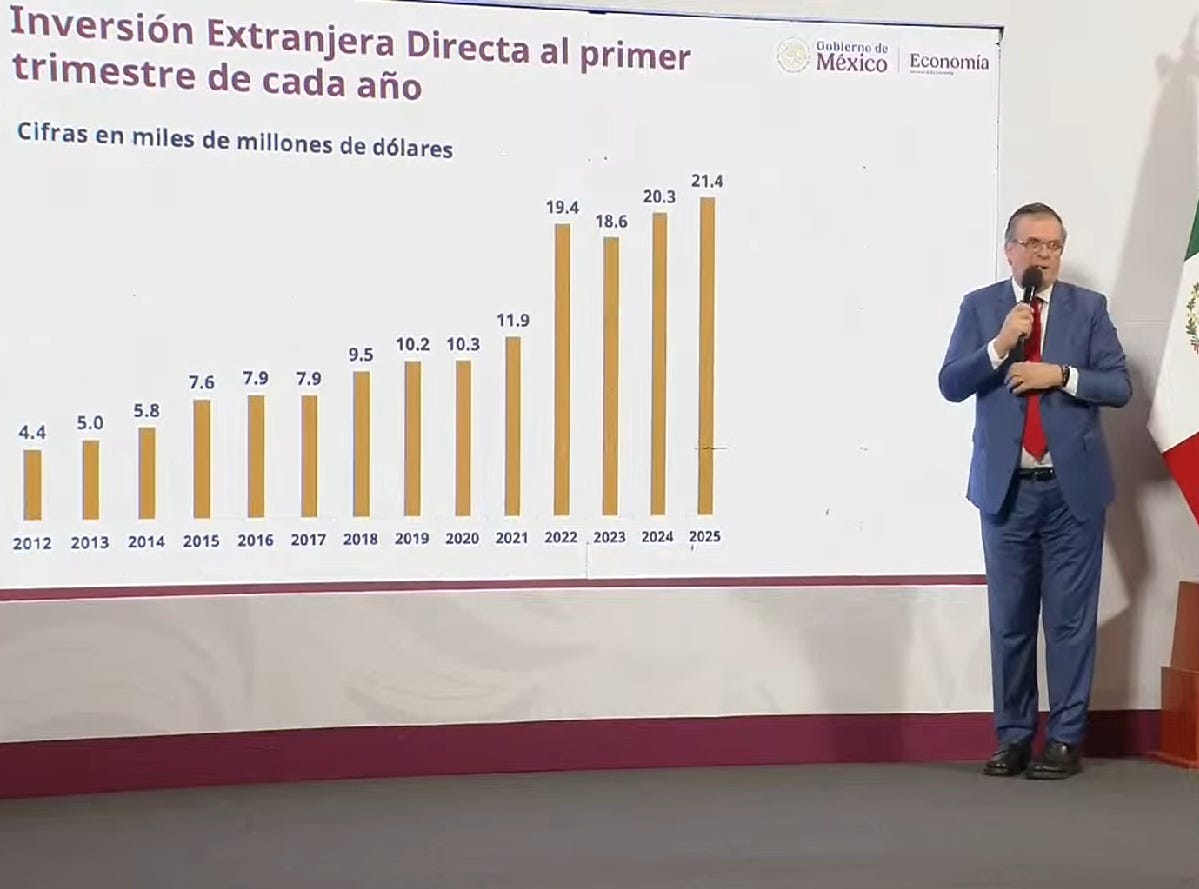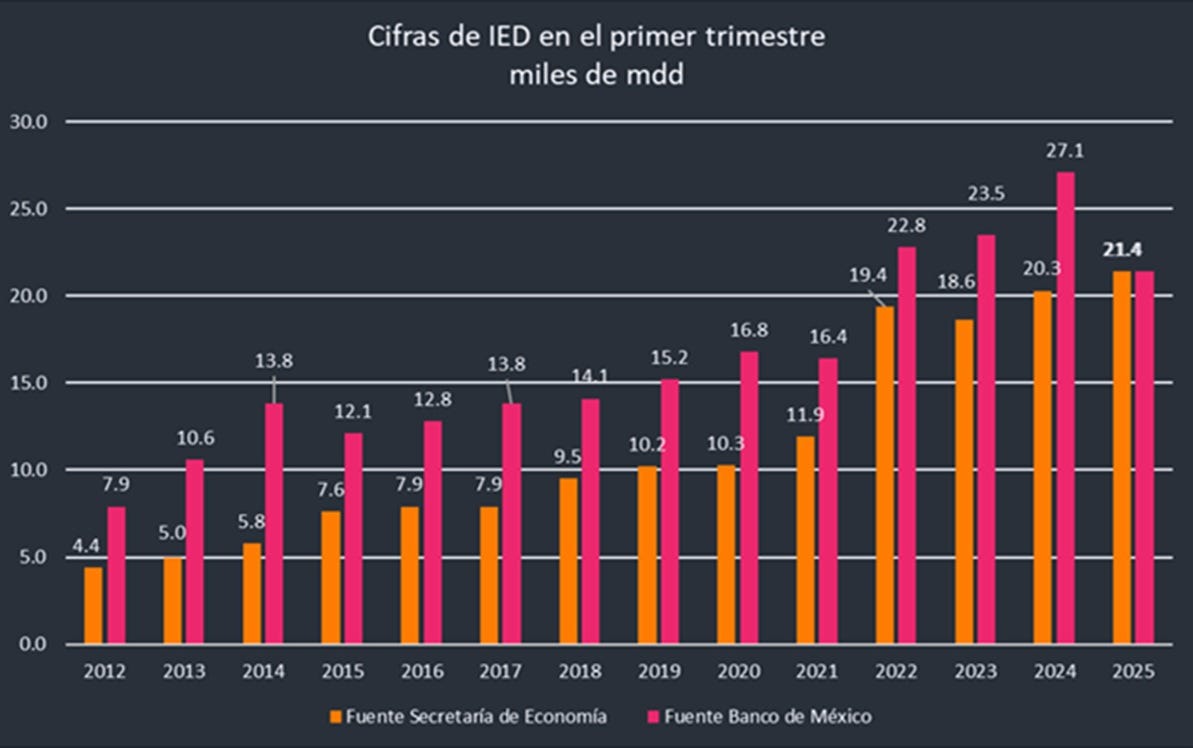Ni histórica, ni en aumento. Ebrard maquilla los datos de inversión extranjera
El secretario de Economía, Marcelo Ebrard, distorsiona las cifras de inversión extranjera directa para presumir un récord que no existe.
To read this article in English click here
Marcelo Ebrard, secretario de Economía, seguramente dejó muy satisfecha a la presidenta Claudia Sheinbaum cuando, a finales de mayo, presentó una de las cifras económicas más esperadas por analistas e inversionistas: la de la inversión extranjera directa (IED) del primer trimestre de este año.
El dato era considerado por muchos como clave para poder evaluar cómo venían afectando al país las tensiones económicas globales desatadas por el presidente estadounidense Donald J. Trump, tras la aplicación de aranceles a múltiples productos de múltiples países.
El jueves 22 de mayo, el funcionario de 65 años aseguró —ante Sheinbaum y los millones que siguen la reunión matutina presidencial— que México, pese a ese entorno internacional adverso, seguía siendo, según él, un destino atractivo para los capitales foráneos.
Al afirmar que la segunda economía más grande de América Latina había recibido un nivel récord de IED en el periodo enero-marzo, Ebrard pareció disipar algunas de las crecientes dudas sobre el rumbo económico del país, alimentadas tanto por el giro proteccionista, nacionalista y populista de Trump, como por las reformas constitucionales impulsadas por la mandataria mexicana para concentrar aún más el poder en su figura y en la de los líderes de su partido, Movimiento Regeneración Nacional (Morena).
“Como ustedes verán”, dijo Ebrard con la elocuencia y seguridad que lo caracterizan, “el último dato es de 21.4 miles de millones de dólares. Es el más alto histórico que hayamos tenido.”
Marcelo Ebrard, secretario de Economía, muestra cifras distorsionadas de inversión extranjera directa durante el primer trimestre de los últimos años durante la reunión matutina de la presidente Claudia Sheinbaum. Foto captura de pantalla de la transmisión de la llamada “Mañanera del pueblo”
El problema no es el monto, sino el adjetivo que eligió: histórico. Ebrard no solo incurrió en una exageración retórica. Su afirmación es falsa. Si bien es cierto que México recibió esa cantidad de dólares en materia de IED durante el primer trimestre de 2025, los datos oficiales de Banco de México, responsable de compilar las cifras de IED como parte de la balanza de pagos del país, desmienten al secretario. Lejos de marcar un récord, el flujo de capital foráneo del primer trimestre de 2025 fue el más bajo de los últimos cuatro años para ese lapso. Tan solo en el mismo periodo de 2024, México recibió 27 mil 55 millones de dólares en IED, una cifra que sí representó un máximo histórico. Además, en 2022 y 2023 los niveles también fueron superiores: 22 mil 785 y 23 mil 511 millones de dólares, respectivamente.
Ebrard no solo engañó al afirmar que se alcanzó un máximo histórico, sino también al asegurar que la inversión mostraba una tendencia ascendente. La realidad es exactamente la contraria. En lugar de avanzar 5.4%, como indicaron las cifras que el funcionario presentó, la IED cayó 21% respecto al primer trimestre del año anterior —su peor desplome para ese periodo desde 2009, cuando se hundió 28.6% al inicio del tercer año del sexenio de Felipe Calderón.
Como ya es costumbre desde hace más de seis años, Ebrard aprovechó la ocasión para lanzar otro golpe contra los gobiernos anteriores, señalados por las administraciones de López Obrador y ahora de Sheinbaum como la raíz de todos los males que han aquejado al país —males que, según ellos, ya han sido erradicados, como son la corrupción, la impunidad, el abuso de poder y las artimañas gubernamentales.
En esa línea argumentativa, el secretario de Economía afirmó que la IED que México está captando es muy superior a la registrada durante los gobiernos “neoliberales”, etiqueta con la que Morena engloba a todas las administraciones de 1982 a 2018.
“El máximo histórico de la etapa neoliberal en materia de inversión extranjera directa fue en 2018, y fue de nueve mil 500 millones de dólares”, dijo Ebrard. “Ese fue su máximo”.
Gráfica que compara las cifras divulgadas por el secretario de Economía, Marcelo Ebrard, y las que ha publicado Banco de México en cuanto a IED para los primeros tres meses del periodo 2012-2025.
Otra aseveración equivocada. Si bien es cierto que el pico de IED de esos gobiernos se dio en el primer trimestre de 2018 —último año del sexenio de Enrique Peña Nieto—, el monto fue de 14 mil 67 millones de dólares, no nueve mil 500. Ebrard redujo casi a la mitad la cifra real.
De hecho, durante el sexenio de Peña Nieto, México recibió un total de 218 mil 711 millones de dólares en IED, 7% más que lo registrado durante el gobierno de López Obrador. Entre 2012 y 2018 se alcanzó el máximo histórico en términos de inversión extranjera directa acumulada.
Durante el sexenio de López Obrador, por el contrario, la IED disminuyó en términos acumulados respecto a la de su antecesor, marcando el primer retroceso de este indicador en cinco administraciones consecutivas.
Además, si se analizan los componentes de la IED, el rubro de nuevas inversiones —es decir, de capitales que nunca antes habían llegado al país— tuvo su peor desempeño en seis sexenios durante el gobierno anterior. De 2019 a 2024, solo 29% de la IED correspondió a nuevas inversiones, el nivel más bajo desde el sexenio de Carlos Salinas de Gortari, de 1988 a 1994. Durante ese gobierno, el porcentaje de inversiones foráneas nuevas fue de 59.1% del total, o más del doble que durante el gobierno de López Obrador.
Desde luego, no se puede concluir que los gobiernos anteriores a Morena fueron mejores solo por haber registrado mayores niveles de IED nueva. Hay muchos otros factores —económicos, sociales, políticos y de seguridad— que deben considerarse para una evaluación sexenal completa. De hecho, las victorias de López Obrador en 2018 y de Sheinbaum en 2024 reflejan un claro mandato ciudadano para cambiar o ratificar el rumbo del país y que ambos propusieron.
No obstante, eso no justifica que los funcionarios públicos distorsionen las cifras para presentar un panorama artificialmente optimista al inicio de este nuevo sexenio. Los inversionistas y analistas saben leer cifras; y también reconocer cuándo alguien intenta maquillarlas.
Not historic, not growing. Ebrard manipulates foreign investment data
Economy Secretary Marcelo Ebrard misrepresented foreign investment data to claim a non-existent record.
by Eduardo García
Marcelo Ebrard, Mexico’s Secretary of the Economy, likely pleased President Claudia Sheinbaum when, in late May, he presented one of the most anticipated economic figures for analysts and investors: the foreign direct investment (FDI) number for the first quarter of the year.
The figure was seen as a key indicator for evaluating how the global economic tensions unleashed by U.S. President Donald J. Trump —through the imposition of tariffs on a wide range of products and countries— were affecting Mexico.
On Thursday, May 22, the 65-year-old official declared —in front of Sheinbaum and the millions who tune in to the daily presidential morning briefing— that Mexico remained, despite an adverse international context, an attractive destination for foreign capital.
By claiming that Latin America’s second-largest economy had received a record level of FDI in the January–March period, Ebrard seemed to dispel growing concerns about the country’s economic direction —concerns fueled both by Trump’s populist, protectionist turn and by the constitutional reforms pushed by Sheinbaum to further consolidate power in herself and the leaders of her party, National Regeneration Movement, or Morena for its Spanish acronym.
“As you can see,” Ebrard said with his characteristic eloquence and confidence, “the latest figure is $21.4 billion. It’s the highest in history.”
Marcelo Ebrard, Secretary of the Economy, presents distorted foreign direct investment figures for the first quarter of recent years during President Claudia Sheinbaum’s morning briefing. Photo screenshot from the broadcast of the so-called “People’s Morning Show.”
The problem isn’t the amount —it’s the adjective: Historic. That statement is not just an exaggeration. It’s false.
While it’s true that Mexico received that amount in FDI in the first quarter of 2025, official figures from Banco de México —the institution responsible for compiling these numbers as part of the country’s balance of payments— contradict the Secretary. Far from setting a record, the Q1 2025 flow of foreign capital was the lowest for that period in the past four years. Just a year earlier, in Q1 2024, Mexico received $27.1 billion —a true historical peak. In 2022 and 2023, the totals were also higher: $22.8 billion and $23.5 billion, respectively.
Ebrard not only misled the public by labeling the figure a “record” —he also falsely claimed that foreign investment was on the rise. In fact, the trend is clearly negative. Instead of increasing 5.4%, as suggested by the Ebrard’s figures, FDI fell 21% compared to the same period a year earlier —the sharpest drop for a first quarter since 2009, when it plunged 28.6% during the third year of Felipe Calderón’s presidency.
As has become routine over the past six years, Ebrard also took the opportunity to attack previous administrations —which both the López Obrador and Sheinbaum governments blame for all of the country’s ills. Ills they claim to have eradicated, such as corruption, impunity, abuse of power, and political manipulation.
Staying on message, the Secretary of the Economy asserted that current FDI levels far exceeded those of the so-called neoliberal era —a term Morena uses to describe all administrations from 1982 to 2018.
“The historic maximum during the neoliberal period in terms of foreign direct investment was in 2018, and it was $9.5 billion,” Ebrard said. “That was their peak.”
Chart comparing the foreign direct investment figures disclosed by Economy Secretary Marcelo Ebrard with those published by the Banco de México for the first quarter of the 2012–2025 period.
Another false statement. While it’s true that FDI reached its peak during that period in Q1 2018 —the final year of Enrique Peña Nieto’s presidency— the actual figure was $14.07 billion, not $9.5 billion. Ebrard understated the number by almost half.
In fact, under Peña Nieto’s six-year term, Mexico received a total of $218.7 billion in FDI —7% more than during the López Obrador administration. Between 2012 and 2018, the country reached its all-time high in cumulative foreign investment.
During López Obrador’s presidency, by contrast, cumulative FDI declined for the first time in five consecutive administrations.
And when analyzing the composition of FDI, the “new investment” component —capital entering the country for the first time— performed worse than in any of the previous six presidential terms. From 2019 to 2024, only 29% of total FDI corresponded to new investments —the lowest share since Carlos Salinas de Gortari’s presidency (1988–1994). Back then, new investments made up 59.1% of total FDI —more than double the recent proportion.
Of course, it would be simplistic to conclude that pre-Morena governments were better simply because they attracted a larger portion of new FDI. A full assessment of any six-year term must include a broader set of political, social, security, and economic variables. In fact, López Obrador’s 2018 victory and Sheinbaum’s 2024 win reflect a democratic mandate to change —or reaffirm— the direction of the country.
Still, none of that justifies public officials manipulating numbers to paint an artificially rosy picture at the start of a new administration.
Investors know how to read data. And they can tell when someone is trying to cover up the real story.








Qué le puede esperar a México con tantas mentiras y sin saber enfrentar los problemas con responsabilidad.
Well done for holding him to account, Eduardo. So not only his words were false but the chart behind him was false too, right?
The abuse of the word "historic" seems borrowed from the Trump playback.